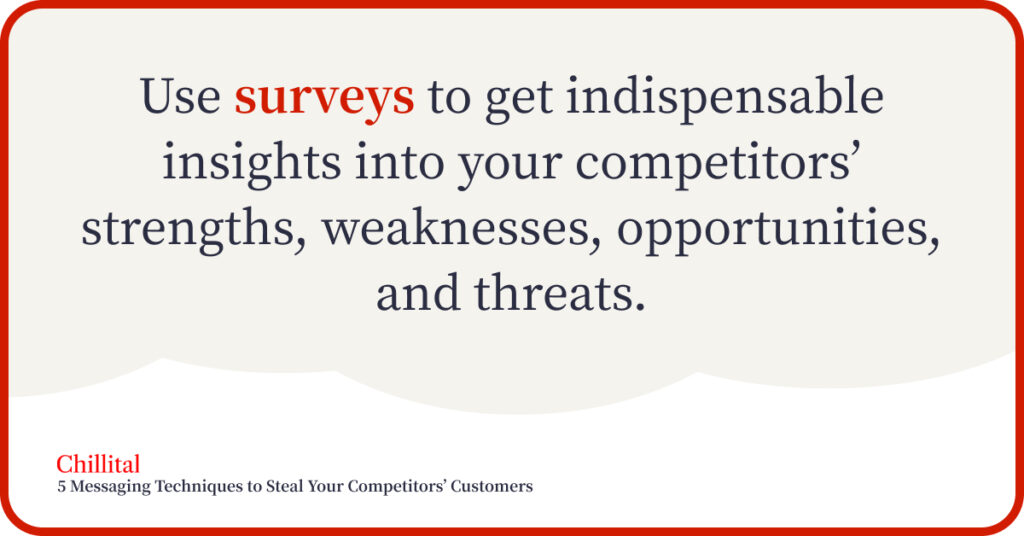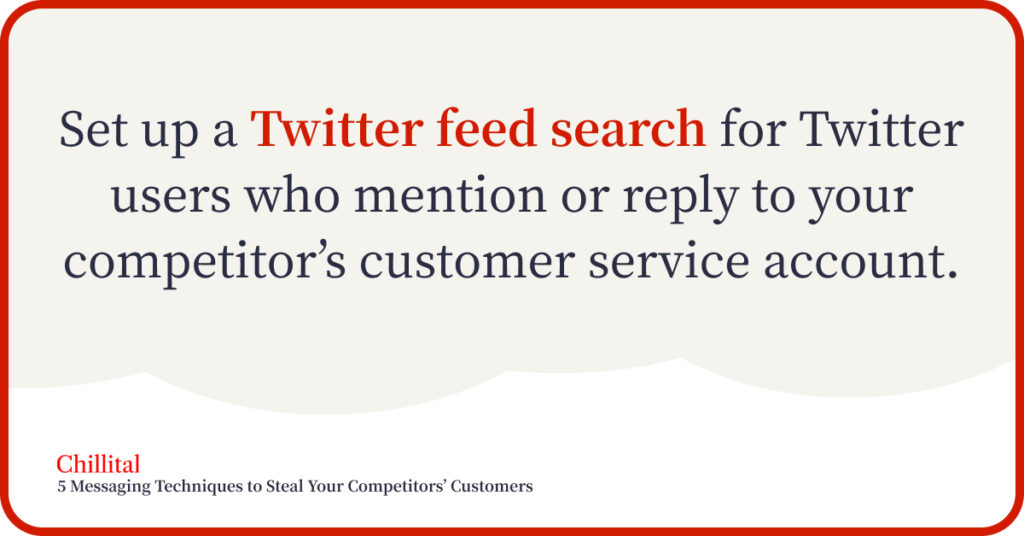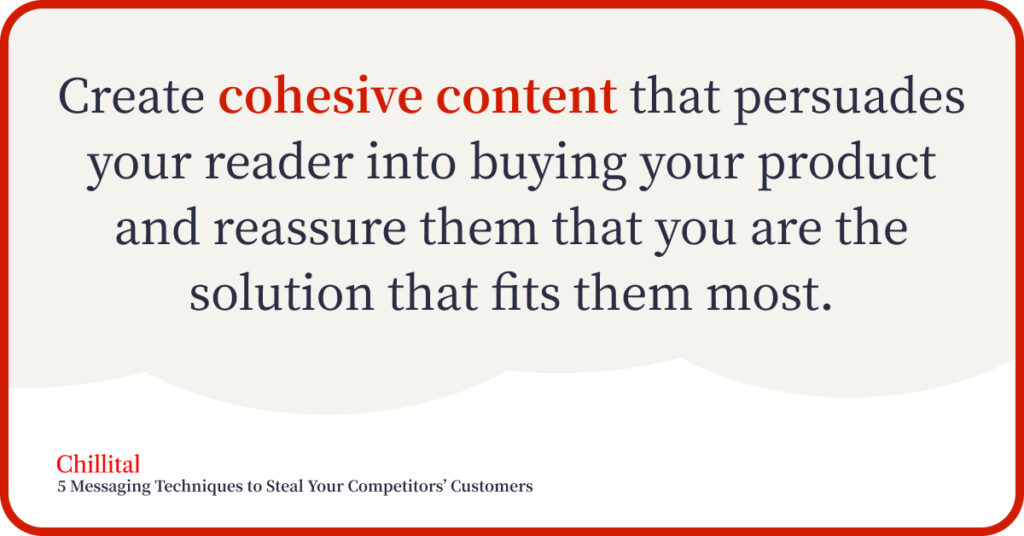Stealing’s not cool, unless we’re talking about awesome techniques to steal your competitors’ customers and make the most of your marketing campaigns.
Talking to your target audience is a fundamental aspect of any kind of marketing strategy. It allows you to understand the motives behind their buying decisions, and what works best when it comes to convincing them to buy from you.
The same goes for approaching your competitors’ customers.
While some businesses lure customers through massive discounts and offers, you might not always be in a position to do so.
Here are 5 messaging techniques to steal your competitors’ customers. Efficiently and long term.
1. Surveys make the world go round

A survey is a proven method for gathering information about your competitors’ customers.
Surveys can provide indispensable insights into your competitors’ strengths, weaknesses, opportunities, and threats.
Conduct a survey of your competitor’s customers and ask them questions about how they perceive their products or services.
You can ask open-ended questions or closed–ended questions – the choice is yours – although I recommend you ask closed-ended, quantifiable questions so that you can better quantify the results.
Some examples of closed-ended questions include:
- How much does [competitor product] benefit you? (from 1-10)
- How happy are you with [competitor product]? (from 1-10)
- How likely are you to recommend [competitor product] to your friends? (from 1-10)
Depending on your goals, you might want to ask open-ended questions. These can help you create content around the answers you receive and adjust your messaging accordingly.
Some examples of open-ended questions include:
- What do you like the most about [competitor]?
- How does [competitor product] benefit you?
- How would you describe the [competitor] customer service?
- How do you feel about [competitor product]?
- What would it take for you to switch from [competitor]?
You’ve got all the questions set up, now what?
Set up a Facebook ads campaign. Check out the “People” section on your competitor’s page to get insights on who the customers are (e.g. age group or city).
Note that this strategy might work only if your competitor is huge in your industry (more like Mailchimp, instead of no-name-email-marketing-software).
If your competitor is a mom-and-pop shop, you’d do better through message mining. More on that below.
How can you use surveys as a messaging technique?
Once you get your answers, it’s pretty easy to incorporate those into your messaging. Use what the customers say to your advantage.
Your landing page copy should address all the pain points discovered through the survey. Reduce the friction and anxieties that come with engaging or buying a brand new product. To steal your competitors’ customers, you need to speak to them directly and address their concerns.
2. Set up alerts

Owning and monitoring your brand and its reputation is more than just listening to what people talk about you on social media – it’s understanding how they feel about you and using that information to improve the experience.
There’s a significant difference between what people say and what they usually mention in their reviews.
Over 77% of business decision-makers decide to do business with a brand based on what others say about them online. And now, you can watch over these social media conversations to see if there are any trends that can help improve your own brand or cause for action.
How do you do this?
Set up a Twitter feed search for Twitter users who mention or reply to your competitor’s customer service account. Reply to them and engage them in productive conversation so you can provide solutions to their needs.
If you’re not on Twitter (why?), then use Mention.
When there is a new product release or a significant update, the competitor’s customers will be one of the best resources to get an understanding of how it works. This is where Mention comes in really handy.
However, you need to identify if people are mentioning your competitors at all. This can include comments on blogs, forums, reviews, and social channels.
How can you use alerts as a messaging technique?
If customers complain about too expensive one-week trials, make sure you advertise your cheaper version.
If customers complain about clunky backlinks checker software, praise how yours is so much better – and why.
3. Create SEO “alternative” pages

One clever technique to steal your competitors’ customers is to create alternative pages.
Have you ever come across an ad that convinced you to click on it, when in fact, you searched for a competitor?

That’s exactly what we want to do here, although we’re creating landing pages or blog content specifically targeting “[competitor] alternative”.
The purpose of these pages is to optimize for keywords related to the competitor’s brand name but also related to “alternative”.
People searching for these keywords are not yet decided on which product to choose, so they browse Google for alternatives.
Some benefits of alternative pages are:
- if a customer wants to switch from a product, they’ll come accross your landing page;
- your [competitor] might be the only option they’re familiar with;
- the intent is not informational, meaning that people searching for alternatives are more likely to convert than others;
- besides getting more organic traffic from these pages, you’re more likely to see increased conversions too.
Here are a few examples:
- 22 Best Mailchimp Alternatives for 2021 (Free and Paid Options)
- The 31 Best Free Asana Alternatives of 2021
- 7 Animoto Alternatives & Competitors for 2021
How can you use alternative pages as a messaging technique?
An alternative page shouldn’t be created with the sole purpose of getting more traffic or hoping to get more customers.
You should actually give solid reasons why the customer should choose you instead of a competitor. Instead of just saying that you’re better, actually prove it. Show pictures and videos of your product and give visitors a reason to try you out.
4. Use message mining to attract them

Message mining involves looking at the publicly available reviews, posts, Tweets, etc. on the internet of your competitors’ customers.
By listening to their opinions about a product or solution, you are giving yourself valuable insight into what your competitors’ customers value most.
In the old days, prospects would tell us what they wanted from a solution. In the new digital age, we have to find them and listen to where they’re talking, so we can partner with them and help them transform their challenges and struggles into solutions — opportunities — for your business.
Message mining is the new “customer development”, helping you gain empathy and insights about the customers’ major pain points and priorities.
When message mining, you should look for:
- what your competitors’ customers value most about the product
- what they hate/don’t like
- any suspicions (why do I need to pay for the software monthly when the free trial offers everything?)
How can you use message mining as a messaging technique?
Here’s a secret. Message mining is usually done for your customers, not your competitors’.
Nonetheless, when you don’t have enough data, mining your competitors’ customers’ messages is a great strategy to incorporate effective copy on your landing pages.
On your sales page, you should use value-focused headlines that address a benefit and a pain point that customers have.
Use emotions to steal your competitors’ customers. If you found out through message mining that customers complain about confusing UI, make that your focus.
5. Write product-led bottom of the funnel content

Each piece of your content should have a purpose.
If you’re working on your overall content strategy, it’s not uncommon to find yourself with a ton of high-level content—like blog posts, infographics, guides, etc.—and not enough of the specific content that prospects and customers at the lower end of the funnel want and need.
The bottom of funnel content is usually product and service-focused, and, if done well, it prompts a conversion.
At this stage, we should assume that the soon-to-be customer already has enough information to be able to make an informed decision.
Similar to alternative pages, they are now ready to compare products and decide which one is best for their needs.
Types for bottom-of-funnel content include:
- alternative pages
- [competitor] vs [you] blog pages
- integration content (does [you] integrate with [specific software]?)
How can you use bottom-of-funnel content as a messaging technique?
At this stage, it’s important to note that you shouldn’t be 100% objective, but actually tell the complete truth.
Besides working on your top-of-funnel content through proven B2B SEO strategies, you should create cohesive content that persuades your reader into buying your product and reassure them that you are the solution that fits them most.
Bringing it all together to create more effective messaging
To recap, stealing your competitors’ customers is a big deal. It can help you land bigger contracts and position you as an authority in your field.
However, for an efficient messaging strategy, you should get to know your competitors’ customers and speak to them in their language.
Need help? Head over to Chillital and let’s spice up your content marketing game.
